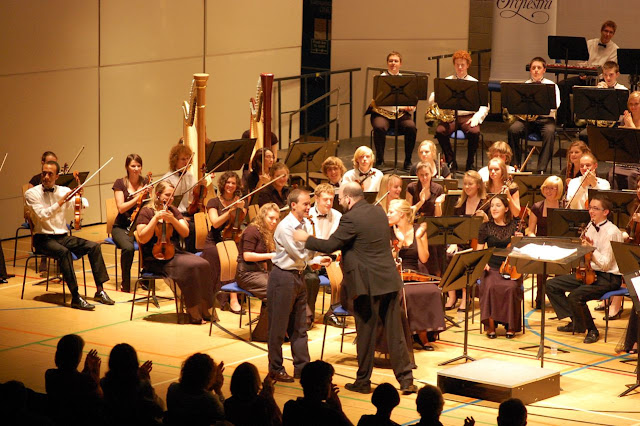In spite of the significant technical challenges for all the players in Philip Sawyers Gale of Life Overture, rehearsals moved along at a quick pace. The main reason for our smooth progress was the immense care Philip had obviously taken in making his writing as idiomatic and his notation as clear as possible. Most Vftp readers have already been there, but you may wish to check out my “tips for composers” which attempts to explain what I consider common sense best practice for getting one’s music played well again and again.
There’s quite a lot of bitonal writing, especially using choirs- for instance the horns often play a chord a step above or below the trumpets and trombones. In addition to the bitonal writing, there’s a lot of quartal and quintal harmony, all of which is fun to work on and satisfying when it starts to ring.
One of the highlights of the whole week for me was the few minutes we spent tuning a passage in parallel thirds in the violins. Going diad by diad, it was so fascinating how this most familiar and friendly of intervals seemed to become more and more alien and exotic as the passage went on, especially once the intonation started to click. I think we all heard the piece with different ears after that. Every once in a while, you’ll have a discovery like that in a rehearsal which is so revelatory that you’re almost tempted to repeat it for the audience before the performance. I mean, why not “ladies and gentlemen, we were rehearsing this the other day, and it sounded so cool by itself we thought we had to share it with you!”
Gale of Life is a bit of a departure for Philip- an intentionally direct concert opener. The piece came about after the premiere of this First Symphony- some musicians were commenting after the concert how the virtuosic scherzo would make a good concert opener on its own. Present that night was David Allan Miller, conductor of the Albany Symphony, who was taken enough with the idea to commission Gale of Life.
According to the composer, the piece is partly an homage to Berlioz, who was an all-time master of the burn-burner overture.

In the interests of getting more of this music known, I’m happy to make available our performance with KCYO the other night. Considering that the original commission stipulated “a virtuoso piece to make the best American brass players break a sweat,” I’m quite proud of how well the orchestra played. We’re sorry the sound quality isn’t first rate- this was recording on a simple mini-disc rig. The next performance is December 4th at the Eugene Symphony, under David Lockington. Click here to listen (about 10 minutes)
Trackbacks/Pingbacks